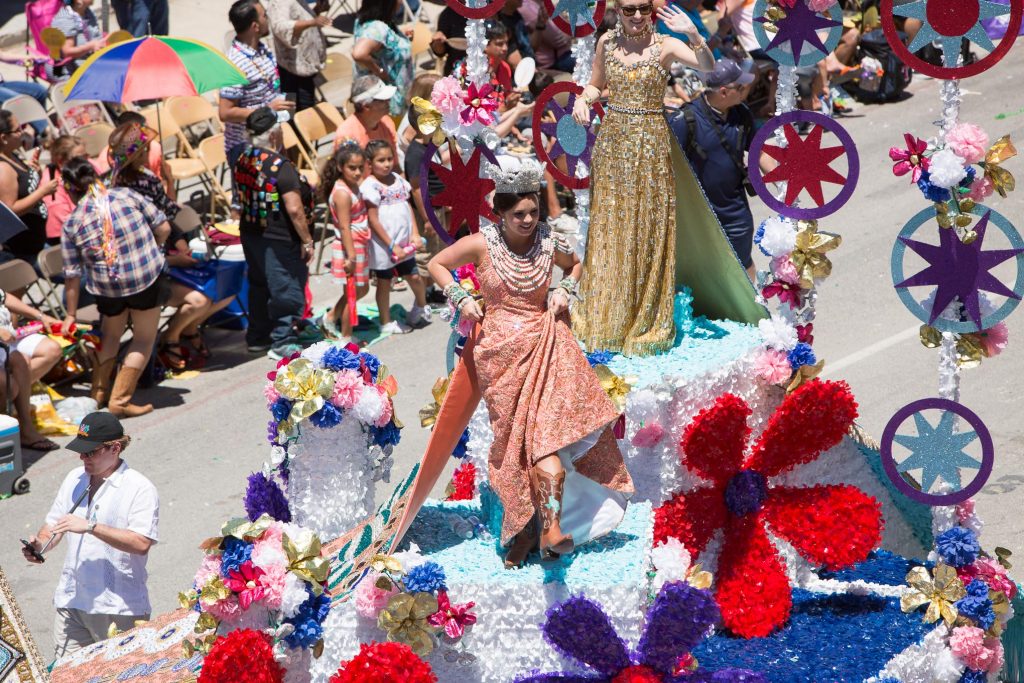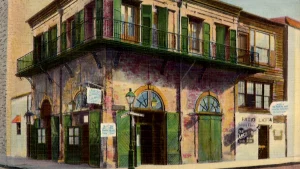Colorful floats; streets closed with barricades; people covering the sidewalks and setting up their lawn chairs to have a good view, having the day off from school; the Marching Bands from High Schools and Universities, decorating their instruments with ribbons, preparing their formation under Highway 37 on Grayson Street; the Fiesta Royalty putting on their best pairs of decorated shoes before stepping onto their throne, mounted on one of the biggest of the parade floats. If you’re a native San Antonian, you know exactly what grand celebration is about occur and what has been going on for the days before; it is part of Fiesta, the ten-day city-wide celebration; it is the Battle of Flowers parade. The Battle of Flowers is a 2.6-mile parade that runs through downtown San Antonio, typically one of the closing events of the Fiesta celebration. This Parades begins on the edge of downtown, and continues onto three major streets: Broadway, Alamo, and Commerce.1 Local schools participate in this parade; their dance troops, mariachi bands, ROTC, and Marching Band programs participate and walk the parade alongside the Texas Cavaliers, the Fiesta Royalty, and the Mayor. Although this annual event has become a hallmark for San Antonians, many don’t know how or when it all began. Let’s go back to its origins, back to the last decade of the nineteenth century in San Antonio.

Originating in 1891, the Battle of Flowers parade was created as a tribute to all those who fought and who fell at the Battles of San Jacinto and the Alamo.2 The idea of a grand celebration to commemorate these heroes came from a tourist, the native-Chicagoan W. J. Ballard. He believed that a proper tribute should be made, and asked a group of local ladies why this had not been the case just yet. His question extended through the city and made its way into newspapers and gained the approval of the community almost instantly. The anticipated idea aroused a spark of interest in Ellen Maury Slayden, a native Virginian elite, who had found her way to San Antonio by marriage to a merchant and later congressman, James L Slayden. Slayden then decided to bring Ballard’s idea to life, and since she knew it was almost impossible on her own, she decided to enlist the help of another newcomer to the area, J. S. Alexander. They both decided to take this on as a pet project of theirs, with the help and support of their husbands. Alexander, a banker before arriving in Texas, provided information on some familiarity he had had overseas about seeing a parade surrounded by flowers, where carts were decorated with flowers. Slayden also remembered similar instances in celebrations she knew about across Mexico and Spain, giving the basis for what the parade would become. The husbands, and many of the elite men of San Antonio, took over the project and had gentlemen speak on behalf of the ladies at the committee meetings; however, as the project grew, the ladies wanted to make sure that it was still a women’s project and continued to provide input and ideas, thus creating the Battle of Flowers Association.3

The parade was originally intended to be an April 21st celebration to celebrate the 55th anniversary of the victory of the Battle of San Jacinto; however, coincidentally, San Antonio was just then expecting its first-ever visit from the White House, the 23rd president of the United States, President Benjamin Harrison. As soon as word got out, the city became ecstatic and prepared a celebration to welcome the President, including moving the parade a day ahead of its original date. With the dates set in stone, the first official planning committee meeting took place only a mere seven days prior to the event. They were frantically trying to gather flowers from nearby towns, since San Antonio had just experienced some heavy rains, which had destroyed most flower gardens, leaving the city with a shortage of flowers just before the parade. Trains were rushed in with shipments of flowers from nearby towns. Other means of making up for the shortage were discussed as well, such as dressing the children up as flowers and having bicyclists decorate their mobiles with whatever blossoms they found and join the parade.4 In the days leading up to the parade, everything seemed all set to go, except for the weather. The city had been plagued with days of heavy rain, and the whole city was hopeful that the rains would cease as the day approached; however, they were wrong. On the morning of the parade, the rains didn’t have mercy on their plans, and as the President’s train arrived, the downpour became continuous. But the rains didn’t stop the city from providing the President with a warm welcome; however, it did postpone the flower parade for the following week, which, of course, would mean that the President would be long gone by then. When the warm weather finally arrived the following week, the parade went as planned; and it was so successful that the committee pushed to have it continue as an annual celebration. It has since been celebrated since 1891, except for the years during World Wars I and II.5

By 1985, the parade continued to grow into the week-long celebration known today as Fiesta. And as the years went by, Kings and Queens were elected as Fiesta Royalty.6 The Parade continues to grow, and so does its recognition across the city and the state. It is now funded by private associations. To this day the parade is one of the closing events of the city-wide, week-long Fiesta party and continues to generate community involvement. Every April, San Antonio puts on a fantastic show, and without a doubt, it all goes back to a Chicagoan tourist, two ladies, and one united community.

- Battle of Flowers, Official Website: Battle of Flowers About us (battleoflfowers.org, 2018). ↵
- Handbook of Texas, June 2010, s.v “Fiesta San Antonio,” by Mrs. Willard E. Simpson, Jr. ↵
- Jack Maguire, A Century of Fiesta in San Antonio (Austin, Texas: Eakin Press, 1990), 13-15. ↵
- Jack Maguire, A Century of Fiesta in San Antonio (Austin, Texas: Eakin Press, 1990), 17. ↵
- Jack Maguire, A Century of Fiesta in San Antonio (Austin, Texas: Eakin Press, 1990), 17; Laura Hernandez-Ehrisman, Inventing the Fiesta City, Heritage and Carnival in San Antonio (New Mexico Press,2008), 21. ↵
- Handbook of Texas, June 2010, s.v. “Fiesta San Antonio,” by Willard E. Simpson, Jr. ↵



117 comments
Clarissa Gonzalez
I was born and raised in San Antonio and liked to think I truly understood the parade for all it was about. That would be a lie after reading this article. I learned so much more about the entire celebration than I had in my whole time living in high school and learning about it every year in school. The historical background within this, shaped a whole new perspective within my head about the celebration. Great read!!
Jocelyn Moreno
I am a proud San Antonian and never did I learn the origin of the Battle of the Flowers. I have participated in the parade and always never saw the purpose of the parade. I will be sure to remember that this upcoming parade, it’s more than just flowers and fun, it is a tribute to those who fought and who fell at the Battles of San Jacinto and the Alamo. I also find it crazy that it wasn’t San Antonians who originated this idea but tourists.
Madison Guerra
I was born and raised in San Antonio and growing up fiesta was one of my favorite things about San Antonio. I always dreamed of being one of the girls in the beautiful dresses on the floats and it was really interesting to learn and read about where it all started. San Antonio has such a beautiful history and this is one of the many things that makes this city so unique in my opinion.
Alyssa Garza
Growing up in San Antonio everyone would get excited for the parade and seeing all the amazing floats that are going to be in the parade. I never really thought of why we had the parade just that we were celebration something. It’s nice to know the origin of the parade and now truly understand it’s meaning and the impact it has on everyone going downtown to see it.
Antoinette Johnson
This article, “Show Me Your Shoes!: The Origins Of San Antonio’s Battle Of Flowers” provided me with more detailed information on the Battle of Flowers. I moved to San Antonio approximately a year ago for college. I heard a little about this event, but not enough to know what it was about. I like the background that women came up with this event to help their husbands. I personally would like to visit the Battle of Flowers to experience the energetic atmosphere that surrounds it.
Austin Pena
Congrats on your nomination. I enjoyed this article and learned all about the history of the parade and what the flowers originally stood for. With the parade coming up i now have a newfound appreciation for all that goes into it. While many might not know the history i thank the author for teaching me something that has an important part of this city’s history.
Rolando Mata
coming from San Antonio this article really hit home in more ways than one. I actually have participated in the battle of the flowers myself on one occasion but never once did I think of its origin and purpose. this article was actually very enlightening as a San Antonian due to its well-formatted structure and well-realized purpose and narrative that was enticing to someone who thought they already knew what they needed to know.
Anais Del Rio
Even though I’m a native San Antonian, I have never participated in Fiesta other than there was no school on the day of Battle of The Flowers. It was interesting how the biggest party of the city came to be because of a tribute to fallen soldiers. It was funny to read that even in the past San Antonio was plagued with harsh storms in April as we usually do.
Seth Castillo
I never knew the reason why we celebrated battle of the flowers. To comemorate the battle of the alamo seems very interesting eventhough we ultimately lost the entire fight. Moving the date of the celebration up because of a visit from the white house seems so obserd now, however, at the time the very first visit from the white house was a emence thing. I find it comical that the weather was still a problem for San Antonio back then.
Destiny Renteria
I come from El Paso and when I first moved to San Antonio i never heard of this until I got here. It is amazing to know that even our 23rd president would have been able to attend the event. It is obviously a big deal and I am glad I can live in a city where there is so much history behind it. I can go back home and gladly tell my family about this so they can be educated as well. Great job to the author for this is a well written article!